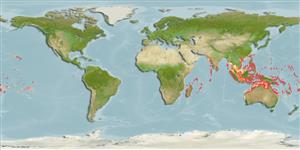Common names from other countries
>
Lophiiformes (Anglerfishes) >
Antennariidae (Frogfishes)
Etymology: Antennatus: From Latin, antenna, antemna = sensory organ, that has got antennae (Ref. 45335).
More on author: Cuvier.
Environment: milieu / climate zone / depth range / distribution range
Écologie
marin récifal; profondeur 0 - 73 m (Ref. 6773), usually 0 - 10 m (Ref. 90102). Tropical; 25°N - 35°S, 29°E - 140°W (Ref. 57379)
Indo-Pacific: East Africa (but apparently absent north of the Chagos Archipelago) to the Philippines and the Moluccas and eastward to island groups of the Pacific Plate.
Taille / Poids / Âge
Maturity: Lm ? range ? - ? cm
Max length : 9.0 cm SL mâle / non sexé; (Ref. 54980)
Description synthétique
Clés d'identification | Morphologie | Morphométrie
Épines dorsales (Total) : 3; Rayons mous dorsaux (Total) : 12; Épines anales: 0; Rayons mous anaux: 7 - 8. Illicium slightly longer than 2nd dorsal spine tapering to a non-filamentous simple tentacle that lacks an esca. Lacks a groove between the upper jaw and base of the illicium. Distinctive color pattern in which there is a broad dark band and marginal dark bands on the anal and caudal fins.
Benthic species (Ref. 58302, 75154) found in inshore coral reef (Ref. 75154). The average depth for all known captures was 11.2 m. Individuals maintained in experimental aquaria change in color from dark gray to light cream within 2 weeks. Oviparous. Eggs are bound in ribbon-like sheath or mass of gelatinous mucus called 'egg raft' or 'veil' (Ref. 6773). Solitary and sometimes among hard coral branches (Ref 90102).
Life cycle and mating behavior
Maturities | Reproduction | Spawnings | Egg(s) | Fecundities | Larves
Oviparous. Eggs are bound in ribbon-like sheath or mass of gelatinous mucus called 'egg raft' or 'veil' (Ref. 6773).
Pietsch, T.W. and D.B. Grobecker, 1987. Frogfishes of the world. Systematics, zoogeography, and behavioral ecology. Stanford University Press, Stanford, California. 420 p. (Ref. 6773)
Statut dans la liste rouge de l'IUCN (Ref. 130435)
CITES (Ref. 128078)
Not Evaluated
Menace pour l'homme
Poisonous to eat
Utilisations par l'homme
Pêcheries: sans intérêt
Outils
Articles particuliers
Télécharger en XML
Sources Internet
Estimates based on models
Preferred temperature (Ref.
115969): 25 - 29.3, mean 28.2 (based on 2427 cells).
Phylogenetic diversity index (Ref.
82804): PD
50 = 0.5002 [Uniqueness, from 0.5 = low to 2.0 = high].
Bayesian length-weight: a=0.01995 (0.00906 - 0.04395), b=3.01 (2.83 - 3.19), in cm Total Length, based on all LWR estimates for this body shape (Ref.
93245).
Niveau trophique (Ref.
69278): 3.8 ±0.7 se; based on size and trophs of closest relatives
Résilience (Ref.
120179): Haut, temps minimum de doublement de population inférieur à 15 mois (Fec assumed to be > 10,000).
Fishing Vulnerability (Ref.
59153): Low vulnerability (10 of 100).
